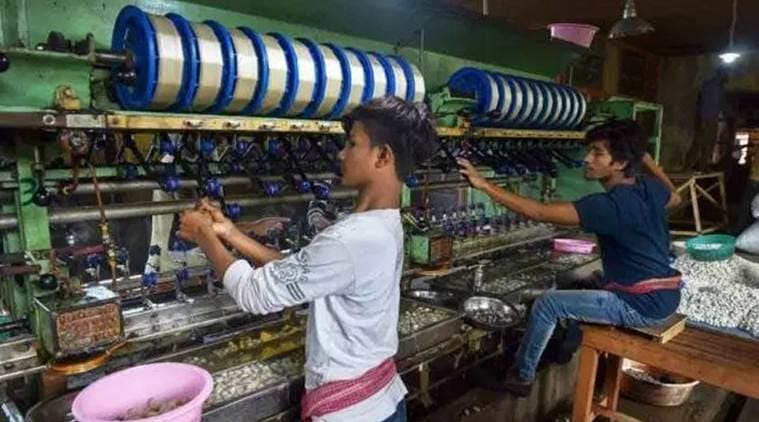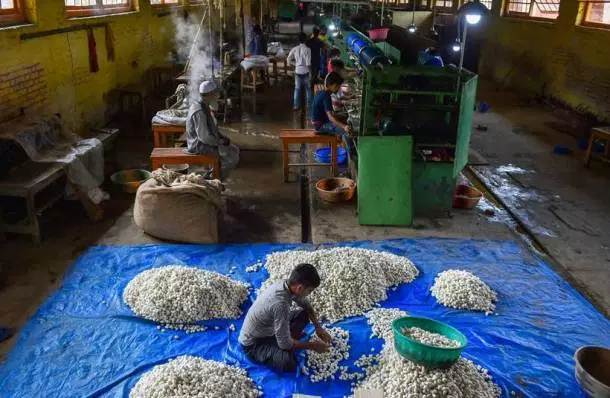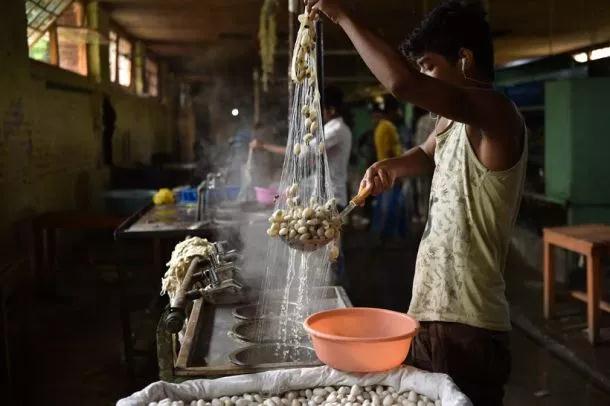Stay updated with the latest - Click here to follow us on Instagram
Mulberry nursery for silk to make way for govt quarters in Srinagar
The move follows a cabinet order passed in April by the PDP-BJP coalition government, which fell in June after the national party withdrew support.
 At the silk factory in Srinagar. PTI
At the silk factory in Srinagar. PTI
A MULBERRY nursery spread over 11.5 acres of agricultural land in the heart of Srinagar will now make way for over 200 residential quarters to house many of the state’s VIPs, legislators and government employees.
The move follows a cabinet order passed in April by the PDP-BJP coalition government, which fell in June after the national party withdrew support. With officials now engaged in soil testing at the site in Alochi Bagh, local sericulture workers say the development will severely hit “one of Kashmir’s oldest industries” and impact jobs. PDP leader and former tourism minister Tassaduq Mufti described his government’s order as “a clear oversight”.
 According to official figures last made available, there has been a steady increase in cocoon production in the state, from over 700 metric tonnes in 2008 to over 1,100 metric tonnes in 2015. The Department of Sericulture, established in 1889, has 173 nurseries spread over 963 acres in the state, and 37 reeling units of which 14 are functional.
According to official figures last made available, there has been a steady increase in cocoon production in the state, from over 700 metric tonnes in 2008 to over 1,100 metric tonnes in 2015. The Department of Sericulture, established in 1889, has 173 nurseries spread over 963 acres in the state, and 37 reeling units of which 14 are functional.
 A labourer sorting mulberry cocoons inside a silk factory at Solina in Srinagar. (Source: PTI)
A labourer sorting mulberry cocoons inside a silk factory at Solina in Srinagar. (Source: PTI)
“The Silk Institute Complex proposal was passed by the outgoing government and the land has been handed over to the Estates department. The plan is to construct over 200 quarters in that complex to accommodate government officials. Currently, we are testing the soil before construction begins,” Tariq Ganai, Director (Estates), said.
The move comes in a year when the PDP-BJP government had reopened the state’s oldest silk factory at the complex after 30 years in an attempt to revive the industry. Set up in 1897 with the help of Sir Thomas Wardle, then president of the Silk Association of Great Britain, the Rajbagh factory was reopened in July under a World Bank-funded project. At the time, officials said the bank had identified the area as a possible heritage site.
 Mulberry cocoons being processed inside the silk factory at Solina in Srinagar. (Source: PTI)
Mulberry cocoons being processed inside the silk factory at Solina in Srinagar. (Source: PTI)
The factory will remain at the site but the mulberry nursery will make way for the quarters, officials said. In the years when the factory was shut, the site had been fragmented into several small plots where some government offices were given space to operate from.
“There are hundreds of people in our towns and villages who take mulberry leaves from these nurseries to raise their own small farms or weave. The move to erase such a big nursery from the landscape of the city will have a huge affect on their lives. They have no other means of employment,” Nazir Ahmad, president, Sericulture Workers’ Association, said.
“The nursery has more than 5,000 mulberry trees that will be felled before construction begins at the complex. Previously as well, parts of the nursery have been used for construction. This is one of Kashmir’s oldest industries and it will not survive if the nurseries are replaced by buildings. These farms cannot be recreated elsewhere in the short term,” Ahmad said.
 Renovation work on the 100-year-old filature in progress at the silk factory at Solina in Srinagar. (Source: PTI)
Renovation work on the 100-year-old filature in progress at the silk factory at Solina in Srinagar. (Source: PTI)
Former minister Tassaduq Mufti said, “At a time when we are trying to preserve our green spaces, this is a clear oversight. I don’t think that in passing this order, we considered the extent of damage this was set to cause.”
According to experts, the construction project comes at a massive environmental cost as “the nurseries serve as the city’s lungs”. Additionally, they say, the project falls inside the flood zone of the city, close to the Jhelum’s flood spill channel.
“Originally, the entire area, including the nursery, warehouses and filatures, was one consolidated unit. Over time, various state governments started cutting the plot up into smaller pieces, giving them to different departments, compromising the site’s integrity,” Gurmeet Rai, conservation architect and consultant for the revival of the silk factory, said.
 According to official figures last made available, there has been a steady increase in cocoon production in the state, from over 700 metric tonnes in 2008 to over 1,100 metric tonnes in 2015. (Source: PTI)
According to official figures last made available, there has been a steady increase in cocoon production in the state, from over 700 metric tonnes in 2008 to over 1,100 metric tonnes in 2015. (Source: PTI)
According to Rai, the factory is protected under the J&K Heritage Conservation and Preservation Act, 2010, which requires the state to prepare a masterplan for the monument to “preserve it in the spirit of its original use”.
“Housing is important, but instead of fracturing the site further, they could find a more feasible site considering factors such as flooding, soil quality and earthquake faultlines,” Rai said.







